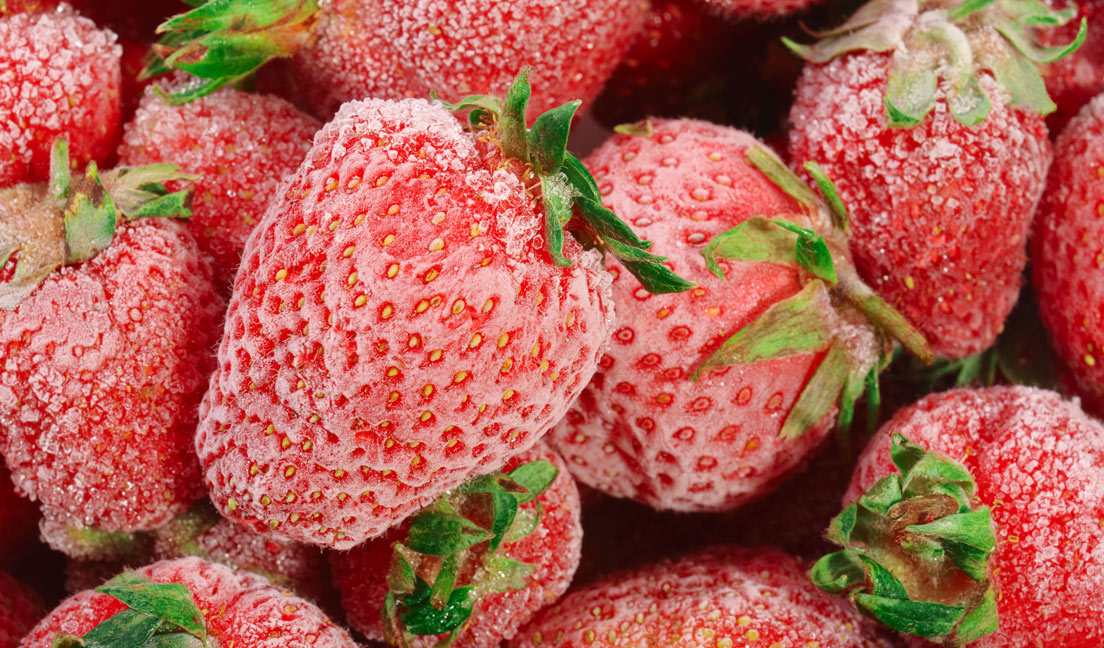A leading provider of packaged fruits required a reliable method for disinfection in its facility, where process and packaging operations for its instantaneous quick freeze (IQF) strawberries and peaches take place. They were able to find success utilizing Evoqua’s proven expertise and superior line of powerful ozone disinfection solutions, which led to improved food safety and quality control.

Challenge
In the frozen food industry, Listeria is a particularly challenging bacteria as it does not go dormant at low temperatures. Bacterial counts also naturally increase throughout processing and packaging, which requires the operator to closely monitor bacterial levels and conduct complete shutdowns for CIP when necessary. Despite their best efforts, chlorine as a disinfectant failed to meet their high-quality standard for microbial control. This resulted in product spoilage and bacterial contamination, wasting valuable product, and impacting plant profitability. The customer took decisive action to find a more effective solution to properly disinfect process equipment and surfaces in contact with their strawberries and peaches.
Solution
In their search for a better way to disinfect and improve their plant profitability, the customer received a recommendation from an outside consultant to speak to Evoqua. After working together to find a solution proven effective against Listeria, mold, E. coli, and numerous other bacteria [1][2], ozone was chosen as the optimum solution to meet their needs. Ozone is very effective at killing microorganisms, delivering a much more rapid kill of bacteria at a lower concentration compared to chlorine. In fact, as an oxidizing agent, ozonated water is 2.2 times stronger than chlorine and is effective for killing a wider variety of microorganisms [3]. It is also an online sanitizer, meaning ozonated water is safe for direct contact with food which enables continuous sanitation without as many frequent shutdowns [4].
The customer opted to install Evoqua’s Pacific Ozone™ PGS Peak Ozone System to deliver stronger surface sanitization throughout its facility.
Beyond achieving a more effective method of sanitation, the operator also utilized Evoqua’s engineering expertise, knowledge of ozone, and practical experience deploying ozone across a variety of applications to deliver a configured ozonation system. The customer partnered with the Evoqua team on application design and component selection, and consulted with a specialist company for the installation of spray systems to help select the applicator nozzles for water usage optimization.
This expertise was critical as nozzles throughout the facility weren’t suitable for ozonated water requiring the Evoqua team to optimize nozzle selection and configuration throughout the facility. Minimizing ozone off gas at the point of application was also crucial to the customer’s success as ozone gas levels must remain below OSHA limits at all times for worker safety [5].
Powered by proprietary and patent-pending technology, the Pacific Ozone™ PGS Peak Ozone System delivers high-efficiency ozone gas dissolution into water. Using Evoqua’s innovative Powertron technology the customer’s operators have precision control over the ozone level in the contact tank to ensure the delivery of the right dosage of residual ozone at each spray point—this is particularly critical for the efficacy of its products and worker safety.
Designed for larger applications, the Pacific Ozone PGS Peak Ozone Injection System is configurable to produce and deliver 18-1120g/h ozone with minimal maintenance. Eliminating the difficulty of integrating the four integral ozone system elements—feed gas preparation, ozone generation, mass transfer with gas management, and process control—Evoqua’s packaged system is configured to meet complex, critical disinfection needs while delivering easy implementation into existing infrastructure.
Results
The customer increased its concentration of disinfectant disseminated throughout its process and packaging operations for IQF strawberries and peaches. Through better microbial control, they have seen a substantial reduction in product loss resulting in significant product savings. Product loss in the fresh produce industry is estimated to be as high as 30 percent so any significant reduction results in increased profits. As one of the largest producers of fruit in the world, the customer is committed to upholding the strictest levels of food safety and pioneering techniques proven to exceed FDA and USDA Organic Certified requirements.
By leveraging ozone disinfection, the customer has also reduced the frequency of their CIP shutdowns. Ozone’s efficacy as a sanitizer has allowed them to extend the time elapsed between disinfections, which has resulted in maximizing line throughput, reducing downtime, and therefore increasing efficiency. Sustainability measures have also been implemented allowing the customer to pause the ozone recirculation when employees are on break, helping the facility reduce its consumption of water.
Following the success of their Pacific Ozone™ PGS Peak Ozone System, the customer is considering expanding the system to adjacent production lines.
RESOURCES
[1] https://reeis.usda.gov/web/crisprojectpages/0185820-surface-destruction-of-listeria-monocytogenes-by-ozone-and-chlorine.html
[2] https://www.wqpmag.com/water-disinfection/ozone-disinfection/article/10954469/ozone-disinfection-eliminating-bacteria-with-ozone
[3] https://www.researchgate.net/figure/Oxidation-potential-of-various-oxidative-species_tbl1_264200863
[4] https://www.ift.org/news-and-publications/food-technology-magazine/issues/1999/october/features/use-of-ozone-to-improve-the-safety-of-fresh-fruits-and-vegetables
[5] https://www.osha.gov/chemicaldata/9
Evoqua Ozone Generation systems undergo factory acceptance testing to ensure they are capable of producing the desired ozone concentration, based on operational parameters outline in the Operating Manual. System performance of microorganism inactivation depends on the CT value, pH, and temperature of water. Performance limitations depend on feed conditions, overall installed system design, and operation and maintenance processes; please refer to Operations Manuals. For more information: Contactus@evoqua.com

